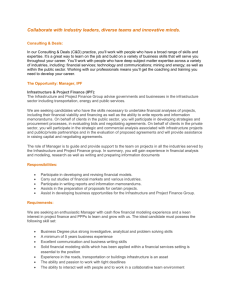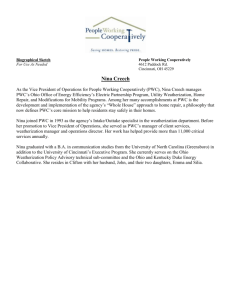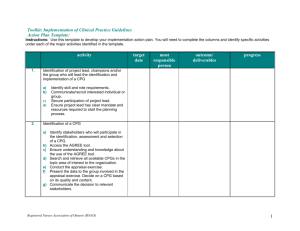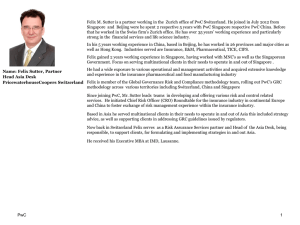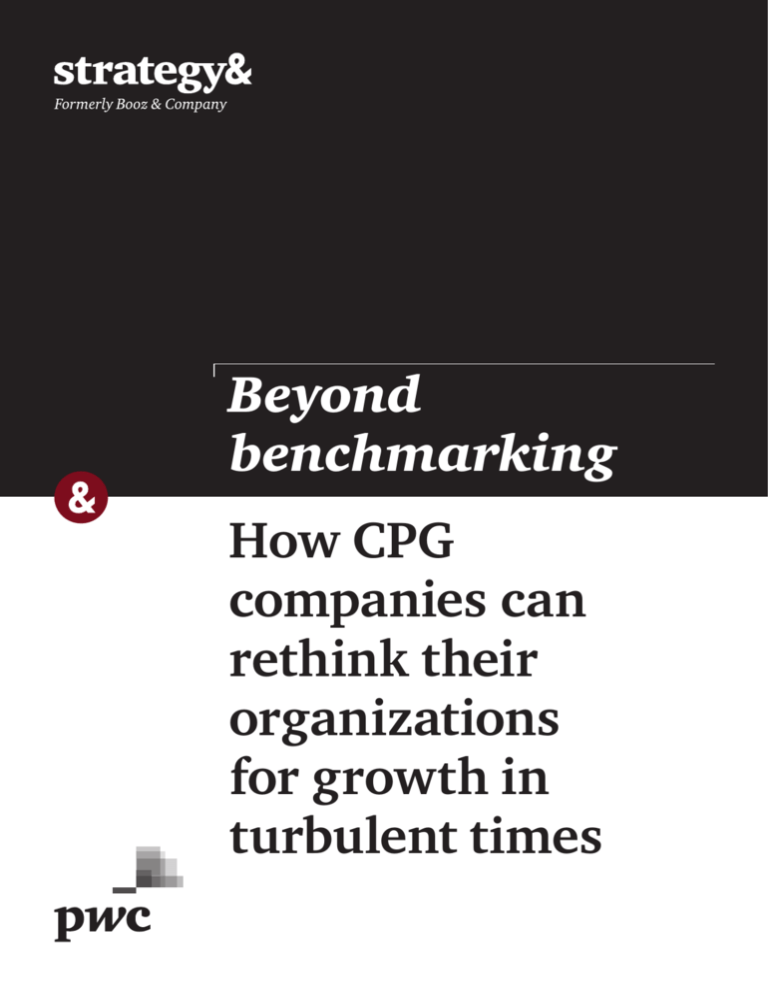
Beyond
benchmarking
How CPG
companies can
rethink their
organizations
for growth in
turbulent times
Contacts
Chicago
Cleveland
London
Mumbai
Deniz Caglar
Partner
+1-312-578-4863
deniz.caglar
@strategyand.pwc.com
Steffen Lauster
Partner
+1-216-902-4222
steffen.lauster
@strategyand.pwc.com
John Potter
Partner
+44-20-7393-3736
john.potter
@strategyand.pwc.com
Abhishek Malhotra
Partner
+91-22-6128-1104
abhishek.malhotra
@strategyand.pwc.com
Cynthia McNeese
Senior Executive Advisor
+1-312-578-4638
cynthia.mcneese
@strategyand.pwc.com
J. Neely
Partner
+1-216-696-1674
j.neely
@strategyand.pwc.com
Richard Rawlinson
Partner
+44-20-7393-3415
richard.rawlinson
@strategyand.pwc.com
New York
Jaya Pandrangi
Partner
+1-216-696-1830
jaya.pandrangi
@strategyand.pwc.com
Mexico City
Akshat Dubey
Principal
+1-216-925-4038
akshat.dubey
@strategyand.pwc.com
2
Carlos Navarro
Partner
+52-55-9178-4209
carlos.navarro
@strategyand.pwc.com
Martha Turner
Partner
+1-212-551-6731
martha.turner
@strategyand.pwc.com
Sydney
Tim Jackson
Partner
+61-2-9321-1923
tim.jackson
@strategyand.pwc.com
Strategy&
About the authors
J. Neely is a partner with Strategy& based in Cleveland. He specializes
in mergers and restructurings.
Jaya Pandrangi is a partner with Strategy& based in Cleveland. Her
work focuses on growth and cost fitness strategies as well as sales and
marketing effectiveness for consumer products and retail companies.
This report was originally published by Booz & Company in 2013.
Strategy&
3
Executive summary
Companies in the consumer packaged goods industry face a number
of challenges. They must balance their investments and attention
between emerging markets (which offer the promise of growth) and
mature markets (which are still far larger but growing at a much
slower rate). At the same time, smaller, focused companies are now
outperforming large players, and companies are slowing their pace of
offshoring and outsourcing. On top of these issues, digital technologies
are creating new ways to interact with consumers.
To succeed in such a complex environment, the industry’s traditional
reliance on benchmarks is not enough. Instead, consumer packaged
goods companies should adopt a five-step approach to organizing for
growth and profitability: (1) define their way to play; (2) focus on
differentiating capabilities; (3) zero-base their costs, to focus
investments only on those key capabilities; (4) use benchmarks
judiciously; and (5) adopt productivity as a way of life.
4
Strategy&
An industry in transition
Companies in the consumer packaged goods (CPG) industry,
particularly food manufacturers, are struggling to deliver ongoing
profitable growth. In North America and Europe, economists and
market analysts are predicting that domestic demand will grow at the
same rate as population, at best. In most regions, consumption levels
have yet to fully bounce back from the slump caused by the last
recession. And for most multinationals, these growth pressures are
only marginally offset by growth in emerging markets. In addition,
commodity cost escalation and price volatility have also put pressure
on margins.
Industry veterans may be tempted to say, “So what else is new?”
Profitable growth in consumer packaged goods, after all, has been
tough to achieve consistently for a decade or more, irrespective of
macroeconomic, regional, or marketplace trends.
The biggest challenge for most consumer products companies today is
the difficult decision about how to organize for different markets around
the world — international markets with promising growth potential on
the one hand, and mature Western markets on the other. Their choices
require a careful balancing act to deliver effectively and efficiently what
each market requires.
What makes this challenging is that competitive pressures in the CPG
industry are far different today than in previous decades. Size, which
traditionally served as a proxy for scale, has ceased to add value, a
change that creates opportunities for focused, smaller players to take
market share.1 Digitization and technology are catalyzing profound
changes in consumer behavior — including the ways people shop
and the manner in which they communicate with companies — and
these changes will accelerate as mobile technologies and “big data”
capabilities evolve further. The need for differentiation has never been
greater. On the other hand, it is still necessary to create and leverage
scale across regions in key capabilities such as innovation and global
brand management. Similarly, greater balance is needed in cost
management and customer intimacy. For example, outsourcing/
offshoring, which had emerged as a viable alternative to building cost
Strategy&
5
advantage through scale, is now being reexamined, and many
companies are looking closely not only at their manufacturing
footprints, but also at where they locate general and administrative
support.
In this world, traditional benchmarking and cost-cutting strategies that
served companies well in the past are no longer sufficient. Instead,
leading companies must align their organization and cost structure to fit
strategic choices for each market they face. This is especially true given
the wide range of starting points for CPG companies across the world.
CPG companies, in effect, need to make their own rules about how best
to organize.
6
Strategy&
Competing in two worlds
The challenges in pursuing profitable growth in two different worlds
are significant. Building businesses with local infrastructure that is
relevant, introducing products to customers for the first time, finding
tailored solutions that work with local customs, and building powerful
global equities — all of these are very different tasks, with investment
profiles very different from competing for share of market and share of
value in mature markets. In setting up a global operating model, CPG
companies face a series of choices. They must decide whether the
business units should be defined by category or by geography, whether
the corporate role should be strategic or operationally focused, and
whether — and how — infrastructure should be shared across business
units and regions.
Each company faces a unique economic and competitive landscape.
Multinational CPG players still generate most of their sales from mature
markets, even though emerging markets are growing much faster (see
Exhibit 1, next page). Yet the range for individual companies varies
widely. For example, Unilever derives 40 percent of sales outside North
America and Europe, whereas Tyson Foods is 95 percent concentrated
in North America. In addition, product portfolio complexity, the number
of countries served, regulatory requirements, and a host of other factors
can differ in significant ways.
No matter the starting point, every company with a global footprint is
salivating at the opportunities in developing markets. Between now and
2020, 95 percent of the world’s 800 million in population growth will be
in the developing world, and 1.4 billion households there will be
earning middle-class incomes. The focus is no longer just on the BRIC
countries (Brazil, Russia, India, and China). In fact, India and Brazil
have lost some of their luster of late. Eastern Europe, Latin America,
Mexico, and Southeast Asia are all on the radar for identifying growth
opportunities and capturing market share.
All of these complexities and uncertainties drive very different tradeoffs on how to organize. We see a range of models being adopted by
different CPG companies to deploy capabilities globally (see Exhibit 2,
page 9).
Strategy&
7
Exhibit 1
Sales per region for CPG multinationals, 2011*
~43% of sales
~25% of sales
~16% of sales
~10% of sales
North America
Europe
South America
Asia
2%–6%
>6%
<2%
Expected GDP growth
KEY: Globe size is relative to the region's overall percentage of sales.
* Campbell Soup Company, Coca-Cola, Diageo, Heinz, Henkel, Anheuser-Busch InBev,
Kellogg, Mattel, Nestlé, Ralph Lauren, and SABMiller. Basket chosen on the basis of
multinational status of companies, multibillion-dollar revenue, and availability of public data.
Total revenue of basket is ~US$270 billion. Last 12-month total revenue for consumer staples
sector is ~$5,682 billion, per S&P Capital IQ.
Note: Remaining ~6% of sales are for the “rest of the world.” Figures for regional split are
taken from calculations and estimates based on company data and literature.
8
Source: Company
websites; OneSource;
World Bank; “Booz CEO:
US Fares Better Than
Europe,” Financial Times
video, Feb. 5, 2012;
Strategy& analysis
Strategy&
Exhibit 2
Operating model choices and companies that use them
Business units organized
by category or geography
Corporate role
Shared infrastructure
(includes outsourcing)
Primarily managed
by category
Managed by
category and geography
Primarily managed
by geography
L’Oréal, Newell Rubbermaid,
Nestlé (waters, nutrition,
pet food, Nespresso)
Procter & Gamble,
Kimberly-Clark,
Kraft Foods Group, Unilever
Coca-Cola,
Nestlé (food and beverage)
Holding
company
Strategy and
oversight
Active
management
Operational
involvement
ConAgra Foods,
Coca-Cola
Procter & Gamble,
Kimberly-Clark
Clorox,
Wrigley
Country- or business
unit–based services
Regional
shared services
Global
shared services
Unilever
Mars, Nestlé,
Kraft Foods Group
Hershey’s, Procter & Gamble,
Coca-Cola, Kimberly-Clark
Source: Strategy& analysis
Strategy&
9
The challenge is to pick markets to focus on, with a viable strategy for
each — often well below the country level. In China, for example, local
tastes, customs, and market characteristics vary widely. As Edward Tse,
Strategy&’s senior executive advisor for Greater China, notes: “Although
China’s markets are global in nature, they are also extraordinarily local,
rooted in traditional customs and tastes, with extreme variations from
one region to the next.”2 Success requires adapting current capabilities
to the unique market conditions and thinking through which
capabilities are applicable in multiple regions, where the company can
leverage scale across regions, and where capabilities can be bought or
borrowed through partnership structures.
For example, one candy manufacturer built a decentralized R&D system
to cater to local tastes and leverage procurement of local raw materials,
supplemented by processes and forums that quickly transfer successful
products and ideas from one market to another. Contrast this with
another food manufacturer that runs global strategic business units
(SBUs) that drive R&D and marketing strategies centrally, while
allowing some tailoring to local needs. This company built a
streamlined process through which managers in each country engage
with the SBUs to tailor offerings and marketing to local needs, with only
three people involved in decision making: the global product manager,
the regional manager, and the country manager.
Participation strategies in global markets also depend on factors such as
unique demand characteristics, the ability to extend brands or acquire
or build relevant local brands, the regulatory landscape, and supply
chain infrastructure.3 Depending on these variables and the expected
growth trajectory, a number of tailored operating models are plausible.
At the highest level, decisions must be made between organic entry and
entry via partnership. Under an organic model, a company must
determine the local sales or marketing resources that are needed and
what decision rights they will have, whether to own distribution or use
a wholesaler-distributor, how to source or structure manufacturing, and
what to hold locally or scale across countries. In partnering approaches,
there must be a very clear statement of objectives, accountabilities, and
appropriate resourcing to deliver on the objectives needed. Because
these decisions are so complex, many companies end up with multiple
operating models across the globe that evolve over time.
In more mature markets, there is a general recognition that relying on
growth in GDP, consumption, and population will not be sufficient to
win. The continued shake-up of grocery retailing pointed out in
Strategy&’s recent study with Food Marketing Institute (FMI) only
confirms this, making it necessary for CPG companies to invest in other
10
Strategy&
growth levers.4 At the Consumer Analyst Group of New York’s 2013
conference for CPG companies, for example, nearly every company
attending emphasized the importance of innovation as a factor in
staying relevant to consumers. Kraft Foods Group has transformed its
innovation capability from its biggest weakness into its biggest strength.
Hillshire Brands aims to gain 13 to 15 percent of revenue from
innovation by 2015, up from an average of 9 percent over the past four
years.
Strategy&
11
Upending old doctrines
If the challenge were simply balancing a highly innovative and
productive model for mature markets with a nimble and flexible model
for entry markets, deciding how to organize would not be all that
difficult for CPG companies. Unfortunately, it is not that simple. On top
of the duality of operating in mature and emerging markets, additional
factors are causing CPG and other industries to reevaluate choices about
investments and costs. In some cases, these are complete reversals of
the doctrines of the last two decades.
Scale matters, but smaller, focused players can outperform. Sheer size
provides cost advantage on many metrics, as any examination of
benchmarks will show. What is interesting, however, is that it does not
guarantee outperformance on a total returns basis. Strategy& recently
completed an analysis of the top 25 food and beverage categories and
found that small players (those with sales of less than US$1 billion) are
outperforming the competition in 18 of these categories, including the
largest ones. These standouts tend to have operating models that are
extremely focused on a few key categories and on a few differentiating
capabilities, creating an insulated competitive model.5 Given the success
of this strategy for smaller companies, larger players need to focus less
on size and more on relevant scale — creating and leveraging scale in a
few critical capabilities.
Outsourcing/offshoring is being reexamined. The reversal in thinking on
outsourcing and offshoring is nothing short of staggering. General
Electric is adding new production lines in its appliances facility in
Kentucky after decades of moving production offshore. Whirlpool and
many other manufacturers also are investing domestically. Drivers of
this trend include not only rising wages in low-cost countries, higher
fuel costs globally, and lower natural gas costs in the U.S., but also more
flexible workforces, better ability to link product development and
design for manufacturing, and increasing concerns about far-flung
supply chains and risks.6 The trend is not restricted to manufacturing.
Many clients are looking closely at elements of general and
administrative costs as well, making the choice to bring more elements
back in house, and finding they can be both more effective and more
efficient. This is perhaps not a surprise. Any major movement tends to
12
Strategy&
swing too far, and the pendulum comes back at some point. Nor is it an
indictment of the concept, which still works in many situations. It is
clear, however, that blindly assuming that outsourcing is the answer is
no longer safe.
Digitization is redefining how to engage with consumers and customers.
C-suite executives identify technology and digitization of consumer
experience as one of the greatest catalysts of change.7 Consumer
adoption of mobile technologies continues to increase dramatically as
functionality and accessibility grow. Although they’re not fully
understood yet, big data–centric analytics are expected to be a
differentiator in tailoring offerings to and communication with the
consumer in the future. There is a unique window of opportunity for
CPG manufacturers to harness the power of these exploding data sets
and analytics to help retailers in shaping shopper experiences, including
the migration from in-store to online purchases.
Strategy&
13
Moving beyond benchmarks
In this new era, benchmarks can provide cues, but one size does not fit
all — and most transformations based on emulating “what other
companies are doing” deliver only short-term value. Every major CPG
firm has been through multiple transformations along these lines. The
pattern is predictable, and organizations have learned to game it. It
starts with a feverish round of establishing baselines and benchmarks.
Next come heated discussions about why the benchmarks don’t apply in
this particular situation, or exercises in parsing the data more and more
finely in an attempt to find comparables for subfunctions at a level of
disaggregation that narrows any analysis down to very small groups of
people. After much debate, each function agrees to some form of
consolidation, such as demand management (e.g., project cuts), and
perhaps looks at pushing some additional work out the door to lowercost providers. In some cases the work itself is redefined or streamlined,
but this often proves harder to do. In the end, a savings target is realized
and a lot of cost comes out, but three years later, inertia overcomes the
reorganization, and the costs all creep back in.
Most
transformations
based on
emulating
“what other
companies are
doing” deliver
only short-term
value.
These failures breed more cynicism for the next time the ugly cycle
comes around. The efforts are demotivating and distracting. They are
laden with undertones and overt statements about organizations being
fat and complacent. They call into question the value of individuals who
show up to work every day, work hard to advance the goals of the
company, and genuinely care about and take pride in what they do. We
know client companies that have been through this every couple of
years. They view it as a necessary evil.
14
Strategy&
Five steps to organize
for growth and profit
Despite the challenges and complexities, the productivity opportunity
in CPG remains substantial, and there is a better way to approach it.
What makes it hard is that there is no easy solution to defining the right
operating model. It starts with an understanding that benchmarking
your operations to those of other companies is only a beginning. It is
necessary to design a deliberate, lean, fit-for-purpose operating model.
Some companies are already doing this. They are streamlining their
operations by making disciplined choices concerning their capabilities,
and undertaking continuous improvement to drive efficiency and
effectiveness. We recommend five steps for helping CPG companies
think through the process:
1. Define your way to play
Companies that thrive in challenging environments have defined how they
add value, built the capabilities required to do so, and ensure that what
they sell fits. Their customers have a clear understanding of how the
company creates value for them, and what is different about the company
compared with its competitors. Their employees understand these concepts
as well — and how their role fits with the company’s strategy. This identity,
or “way to play,” defines the company’s focus and prevents it from being all
things to all people. It allows the articulation of what the company will or
will not do. There are a number of pure-tone ways to play, but in practice,
companies are a composite of a very limited set.
By focusing their way to play, the strongest companies are able to turn
industry evolution to their advantage, developing and deploying
differentiating capabilities and forcing competitors into other, less
attractive corners of the market. In effect, they become
supercompetitors, driving industry evolution rather than riding along
with it. The only way to reach such a dominant position is by
differentiating through capabilities — being uniquely better at
something that is at the heart of how you add value.
Hershey’s, for example, has very successfully focused on driving
innovation in its core confectionery categories, owning critical seasons
Strategy&
15
like Halloween, Christmas, Easter, and Valentine’s Day in North
America, while organically taking iconic products like Hershey’s Kisses
to international markets. Reckitt Benckiser has been extremely
successful with its sharply honed innovation model, applied consistently
to power brands. This includes sensing consumer micro-needs and
extending product variants to meet those needs. For example, the
company now offers its Nurofen brand of pain relief medications in
standard, express, topical, and other indication-specific forms as well as
pharmacy-only formulations.
2. Focus on differentiating capabilities
Companies that know their way to play also are adept at defining and
investing in a few essential differentiating capabilities to create value,
have a clear lens through which they prioritize investment, and spend
less everywhere else. In many companies, the tendency is to aim for
excellence across the board. Many strive for functional excellence for its
own sake. However, the more judicious approach is to excel at a finite
number of things, and invest in these areas to be best in class.
If a company’s winning play involves fast-paced, flavor-based
innovation, for example, it should be building a rapid innovation and
commercialization capability. A company that focuses on developing
science- and claims-based products, on the other hand, should build an
end-to-end innovation capability that includes gaining approvals from
relevant authorities for claims. Even in support functions like human
resources, a talent management model that enables seamless transfer of
key expertise across geographies could be a differentiating capability
for some multinational companies.
3. Zero-base everything
Companies that have the most success with strategic cost management
practice a zero-basing approach to budgeting. Though the specifics of
this approach may vary, the underlying principle is the same: The
current cost structure is not taken as a given for the next planning cycle.
The approach we recommend makes a distinction between costs
associated with differentiating capabilities and those for all other
activities. Designing a robust management process that applies this lens
to annual planning and budgeting exercises can create a strong
business-performance management discipline. For all costs not
associated with differentiating capabilities, companies can pursue
multiple approaches to streamline costs, such as benchmark-driven
target setting, continuous improvement through lean methods, and
other structural changes like consolidation and outsourcing.
16
Strategy&
Recent examples of this approach are especially evident in private
models, such as 3G Capital’s influence on cost reduction through the
merger of InBev and Anheuser-Busch, and the expectation of similar
pressures to come at Heinz. In our experience, companies that adopt a
new and more efficient global operating model often see 10 to 20
percent reductions in costs as a result.
4. Use benchmarks judiciously
Given the complexity and unique value promise of businesses,
traditional benchmarking provides directional guidance at best. The
ideal use of benchmarks is in a top-down exercise — i.e., to measure the
gap at the highest level and to understand the drivers of the gap. This
helps you put a stake in the ground on the opportunity. It is then
judicious to move forward to a bottom-up effort and challenge the
organization to think innovatively about the cost structure. Any number
of traditional cost management tools can be leveraged to capture the
opportunity, such as business-process reengineering; lean; or inherent,
structural, systemic, and realized (ISSR) cost analysis.
5. Adopt productivity as a way of life
Companies that have adopted the above approach develop a strong
productivity culture. Companies like Church & Dwight have created
their own unique approach that embodies the principles discussed here.
Church & Dwight’s value proposition rests on a portfolio of brands —
both premium and lower-cost — that hold leadership positions in niche
categories. The company acquires brands with residual equity in these
categories and adds value by enhancing their distribution. It focuses on
a small set of power brands at a time, supported by pioneering
innovation — sometimes leading, sometimes following, depending on
their position in the category. These investments are enabled by
aggressive overhead cost management, often described as a “private
equity–like” financial culture. Other companies have developed their
own brands of productivity focus, such as comprehensive margin
management or lean-focused centers of excellence, and have embedded
them deeply into their cultures.
Strategy&
17
Fit for purpose
CPG companies face new and increasing challenges of geographic
emphasis, growing product portfolios, and changing customer
expectations — all driving complexity in their operating models. Now
more than ever it is necessary to develop your own principles, and your
distinct way to play based on your differentiating capabilities, rather
than on traditional, imprecise benchmarking. These principles and this
approach are particularly relevant for companies that have undergone
multiple restructuring efforts in recent years and yet find themselves
struggling with excess costs and resource-starved capabilities. Each
company’s model will be its own, but each must be fit for purpose. The
reward will be in building your own right to win in the specific markets
where you have the best expectations for continued, profitable growth.
18
Strategy&
Endnotes
Elisabeth Hartley, Steffen Lauster, and J. Neely, “The Big Bite of Small
Brands,” strategy+business, Autumn 2013.
1
Edward Tse, The China Strategy: Harnessing the Power of the World’s
Fastest-Growing Economy (Basic Books, 2010).
2
Vikas Sehgal, Steffen Lauster, Erwin Mayr, and Ganesh Panneer, “Roasted
or Fried: How to Succeed with Emerging Market Consumers,” Strategy&,
2010.
3
“New Food Retail Industry Outlook Is Personal, Digital and Virtual,”
Strategy&, 2013.
4
Elisabeth Hartley, Steffen Lauster, and J. Neely, “The Big Bite of Small
Brands,” strategy+business, Autumn 2013.
5
Jordan Weissmann, “Surprise! The U.S. Is Stealing Jobs from China,” The
Atlantic, May 2012.
6
Video interview with Nick Hodson and Thom Blischok, “The Future of Food
Shopping: Personal, Digital, and Virtual,” Strategy&, 2013.
7
Strategy&
19
Strategy& is a global team
of practical strategists
committed to helping you
seize essential advantage.
We do that by working
alongside you to solve your
toughest problems and
helping you capture your
greatest opportunities.
These are complex and
high-stakes undertakings
— often game-changing
transformations. We bring
100 years of strategy
consulting experience
and the unrivaled industry
and functional capabilities
of the PwC network to the
task. Whether you’re
charting your corporate
strategy, transforming a
function or business unit, or
building critical capabilities,
we’ll help you create the
value you’re looking for
with speed, confidence,
and impact.
We are a member of the
PwC network of firms in
157 countries with more
than 184,000 people
committed to delivering
quality in assurance, tax,
and advisory services. Tell us
what matters to you and find
out more by visiting us at
strategyand.pwc.com.
This report was originally published by Booz & Company in 2013.
www.strategyand.pwc.com
© 2013 PwC. All rights reserved. PwC refers to the PwC network and/or one or more of its member firms, each of which is a separate legal entity. Please see www.pwc.com/structure for further
details. Disclaimer: This content is for general information purposes only, and should not be used as a substitute for consultation with professional advisors.

